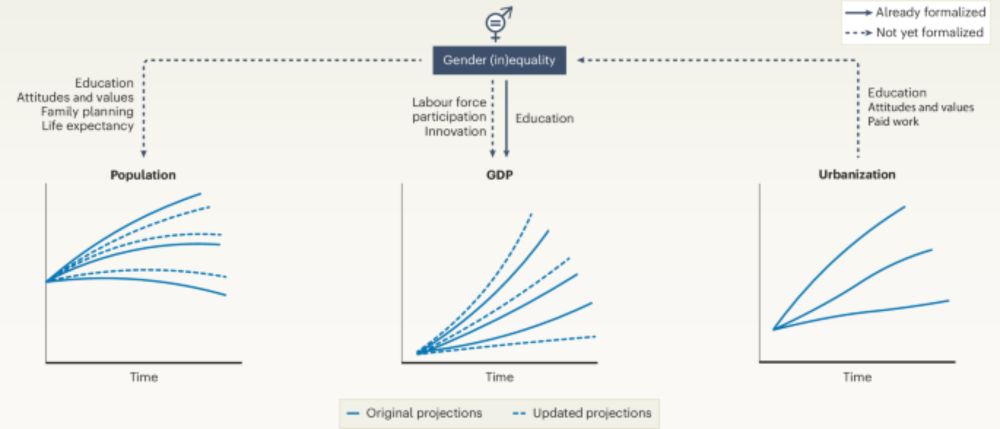
Marina Andrijevic
@andrijevic.bsky.social
Researcher at IIASA | Climate change | Politics | Gender equality | Formerly reading and cycling, now rolling on the floor with my toddler
Reposted by Marina Andrijevic
The richest 10% of people worldwide contributed to about two-thirds of global warming since 1990, and the top 1% alone about one-fifth. If the entire world had emitted like the bottom 50%, there would have been minimal warming since 1990. Lot more in there (check out this figure) 👇
3/
3/

May 7, 2025 at 3:02 PM
The richest 10% of people worldwide contributed to about two-thirds of global warming since 1990, and the top 1% alone about one-fifth. If the entire world had emitted like the bottom 50%, there would have been minimal warming since 1990. Lot more in there (check out this figure) 👇
3/
3/
It was explained to me by one of the authors of the Env-Growth projections that the differentiation across SSPs is driven by changes in the age structure of working-age population by gender, not by specific assumptions on LFPR that would reflect equality. In other words: opportunities for papers:)
February 10, 2025 at 9:38 AM
It was explained to me by one of the authors of the Env-Growth projections that the differentiation across SSPs is driven by changes in the age structure of working-age population by gender, not by specific assumptions on LFPR that would reflect equality. In other words: opportunities for papers:)
From theory and empirical evidence we know that women's LFPRs are influenced by more than education or age (provision of childcare being the no. 1 candidate determinant) but surely it's a good start.
February 10, 2025 at 9:38 AM
From theory and empirical evidence we know that women's LFPRs are influenced by more than education or age (provision of childcare being the no. 1 candidate determinant) but surely it's a good start.
Thanks Florian:) My understanding is that even though they're disaggregated, they don't assume much (if any?) change from the current LFPR for women. But if this is wrong - please point me to any documentation of the assumptions for how the rates may change in the future!
February 7, 2025 at 2:37 PM
Thanks Florian:) My understanding is that even though they're disaggregated, they don't assume much (if any?) change from the current LFPR for women. But if this is wrong - please point me to any documentation of the assumptions for how the rates may change in the future!
It was amazing to work with Caroline Zimm, Shonali Pachauri, Raya Muttarak, Jonathan Moyer. A big thanks to @sparccle.bsky.social for powering this research!
I’m so excited about this paper being out that I may have managed to overcome my social media anxiety. Please share!
I’m so excited about this paper being out that I may have managed to overcome my social media anxiety. Please share!
February 4, 2025 at 10:10 AM
It was amazing to work with Caroline Zimm, Shonali Pachauri, Raya Muttarak, Jonathan Moyer. A big thanks to @sparccle.bsky.social for powering this research!
I’m so excited about this paper being out that I may have managed to overcome my social media anxiety. Please share!
I’m so excited about this paper being out that I may have managed to overcome my social media anxiety. Please share!
For lots more examples, details for scenario enthusiasts, and more, check out the paper in @natclimchange.bsky.social : doi.org/10.1038/s415...

Representing gender inequality in scenarios improves understanding of climate challenges - Nature Climate Change
This Perspective highlights links between gender inequality and climate change adaptation and mitigation, and proposes a roadmap for incorporating gender issues into the Shared Socioeconomic Pathways....
doi.org
February 4, 2025 at 10:10 AM
For lots more examples, details for scenario enthusiasts, and more, check out the paper in @natclimchange.bsky.social : doi.org/10.1038/s415...
Would be great if we lead by example: improving gender balance and diversity within the scientific community is perhaps a first step to enhance representation of gender in scientific output.
February 4, 2025 at 10:10 AM
Would be great if we lead by example: improving gender balance and diversity within the scientific community is perhaps a first step to enhance representation of gender in scientific output.
This reminded me of this post by davidho.bsky.social : bsky.app/profile/davi...
February 4, 2025 at 10:10 AM
This reminded me of this post by davidho.bsky.social : bsky.app/profile/davi...
What would universal secondary education for girls do for global development? What if all women in agriculture had sufficient money and information? What innovations would we have if women in STEM doubled? Would the global governance of crises be better if we had more gender equal politics?
February 4, 2025 at 10:10 AM
What would universal secondary education for girls do for global development? What if all women in agriculture had sufficient money and information? What innovations would we have if women in STEM doubled? Would the global governance of crises be better if we had more gender equal politics?
Scenarios are at the heart of assessments that enable us to say something about climate impacts & responses to climate change in the near and far future. And they are a great research tool for asking big what-if questions.
February 4, 2025 at 10:10 AM
Scenarios are at the heart of assessments that enable us to say something about climate impacts & responses to climate change in the near and far future. And they are a great research tool for asking big what-if questions.

